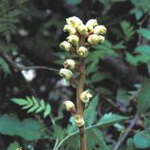| Common Name: |
Gastrodia elata |
| Botanical Name: |
Gastrodia elata |
| Genus: |
Gastrodia |
| Family: |
Orchidaceae |
| Cultivation: |
Damp rich soil in shade, in association with a fungal partner. |
| Propagation: |
By seed sown when ripe in the natural habitat near existing colonies, or on to a bed of Quercus wood, inoculated with the fungus Armillariella mellea; by division of rhizomes during dormancy. |
| Harvest: |
Rhizomes are lifted in autumn and dried for use in decoctions. |
| Native Location: |
China, Japan, Korea, Tibet, Siberia. |
| Height: |
60cm-1m (2-3ft) |
| Width: |
30cm (12in) |
| Hardiness: |
Z2-8 |
| Parts Used: |
Rhizomes (tian ma) |
| Properties: |
A sweet, acrid, sedative herb that lowers blood pressure, relieves pain, stimulates bile flow, and relaxes spasms. |
| Medicinal Uses: |
Internally for convulsive illnesses (such as epilepsy and tetanus), rheumatoid arthritis, vertigo, and numbness associated with liver disharmony. |
| Bibliography: |
Encyclopedia of Herbs by Deni Bown. Copyright © 1995, 2001 Dorling Kindersley Limited. pp 220-221
|

